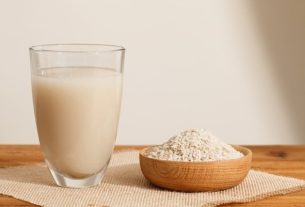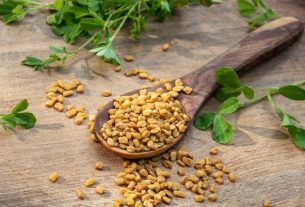The hibiscus (Hibiscus sabdariffa) is a medicinal plant rich in flavonoids and polyphenols, which are bioactive compounds with antioxidant action that fight free radicals, helping to prevent diseases such as high blood pressure and diabetes.
In addition, hibiscus, which is also known as vinegar or sorrel, also contains chlorogenic acid and caffeic acid, phenolic compounds that help control appetite, promoting weight loss.
Hibiscus flowers can be found in red, purple, pink or white and vary in antioxidant and flavonoid content. Hibiscus is sold in dehydrated or powdered form and is used to prepare juices, teas, salads and jellies. Furthermore, this plant is also found in capsule supplement form.

What is it for
The main health benefits of hibiscus are:
1. Prevent premature aging
Because it is rich in antioxidant compounds, such as anthocyanins, flavonoids and tannins, hibiscus helps fight free radicals, preventing the appearance of sagging, wrinkles and premature aging.
2. Lower “bad” cholesterol
Hibiscus helps reduce levels of total cholesterol and “bad” cholesterol, LDL, in the blood as it is rich in catechins, bioactive compounds that inhibit the absorption of cholesterol and the production of fats in the liver.
Furthermore, hibiscus also combats excess free radicals, preventing the oxidation of fat cells and thus helping to control cholesterol and triglyceride levels in the blood.
3. Control high blood pressure
Hibiscus is rich in anthocyanins, which are polyphenols with antioxidant action that promote the relaxation of blood vessels, facilitating blood circulation and thus helping to control high blood pressure.
Furthermore, the anthocyanins present in hibiscus also have a diuretic action, helping to eliminate excess sodium from the body through urine.
4. Help you lose weight
Because it is rich in polyphenols and phenolic compounds such as anthocyanins, flavonoids, chlorogenic acid and caffeic acid, hibiscus can help you lose weight and prevent obesity.
This benefit occurs because these bioactive compounds regulate the levels of some hormones related to appetite, such as ghrelin and leptin, helping to control hunger and reduce food intake. See how hibiscus can help you lose weight.
5. Prevent diabetes
Hibiscus inhibits the action of alpha-amylase and alpha-glucosidase, which are one of the enzymes responsible for the digestion of carbohydrates, promoting the balance of blood glucose levels and thus preventing insulin resistance and diabetes.
6. Avoid urinary infections
Hibiscus has antimicrobial properties, helping to fight bacteria Escherichia coli e Klebsiella pneumoniaewhich are microorganisms related to urinary infections.
Furthermore, hibiscus also has a diuretic action, helping to increase the volume of urine produced, favoring the elimination of these bacteria and preventing the emergence of recurrent urinary infections.
7. Maintain liver health
Because it is rich in anthocyanins with antioxidant and anti-inflammatory action, hibiscus maintains liver health, as it can inhibit the accumulation of fat in the liver and protect the cells of this organ against damage caused by free radicals or the use of medications.
8. Reduce the risk of cancer
Hibiscus is a plant that can reduce the risk of cancer because it is rich in antioxidant and immunomodulatory bioactive compounds, which strengthen the immune system, inhibiting the emergence and multiplication of cancer cells.
However, studies with humans are still needed to prove the benefits of hibiscus in preventing cancer.
How to consume
Hibiscus is mainly used in the form of tea, which can be prepared with dried flowers, sachets or powder. Hibiscus flowers can also be used to prepare recipes such as juices, jellies, sauces and mousses.
In addition, hibiscus is also found in the form of capsule or powder supplements, generally taking 500 to 1000 mg per day. See how to take hibiscus in capsules.
How to make hibiscus tea
To make hibiscus tea, use the dried flowers, sachets or soluble powder.
Ingredients:
- 1 tablespoon of dried hibiscus flowers;
- 400 ml of water.
Preparation mode:
In a pan, boil the water and, after turning off the heat, add the hibiscus flowers. Cover the pan and let it rest for 5 minutes. Strain and drink then. You can drink up to 3 cups of this tea per day. Check out more about how to consume hibiscus tea.
Possible side effects
Excessive intake of hibiscus can cause excess gas, stomach pain, constipation and low blood pressure.
Contraindications
Hibiscus is contraindicated for pregnant or breastfeeding women, as it can cause miscarriage or affect the baby’s health. Hibiscus is also not recommended for children under 12 years of age and for people with kidney or liver disease.
People who use medications for high blood pressure, diabetes, non-steroidal anti-inflammatory drugs or chloroquine should only use hibiscus under the guidance of a doctor, as this plant can alter the effects of these medications.

Sign up for our newsletter and stay up to date with exclusive news
that can transform your routine!
Warning: Undefined array key "title" in /home/storelat/public_html/wp-content/plugins/link-whisper-premium/templates/frontend/related-posts.php on line 12
Warning: Undefined array key "title_tag" in /home/storelat/public_html/wp-content/plugins/link-whisper-premium/templates/frontend/related-posts.php on line 13



